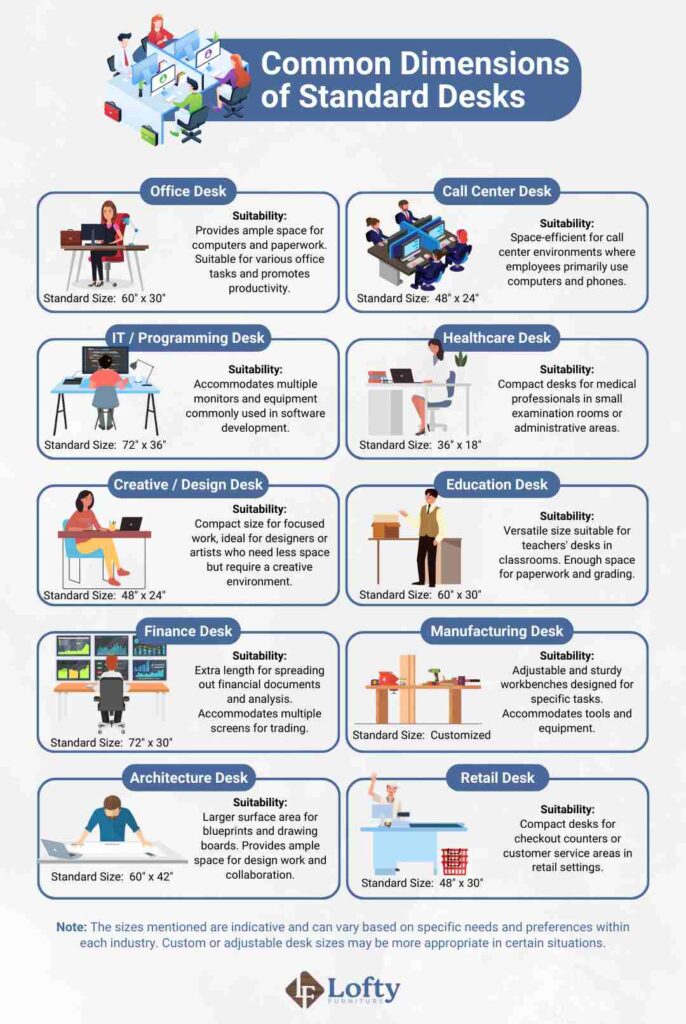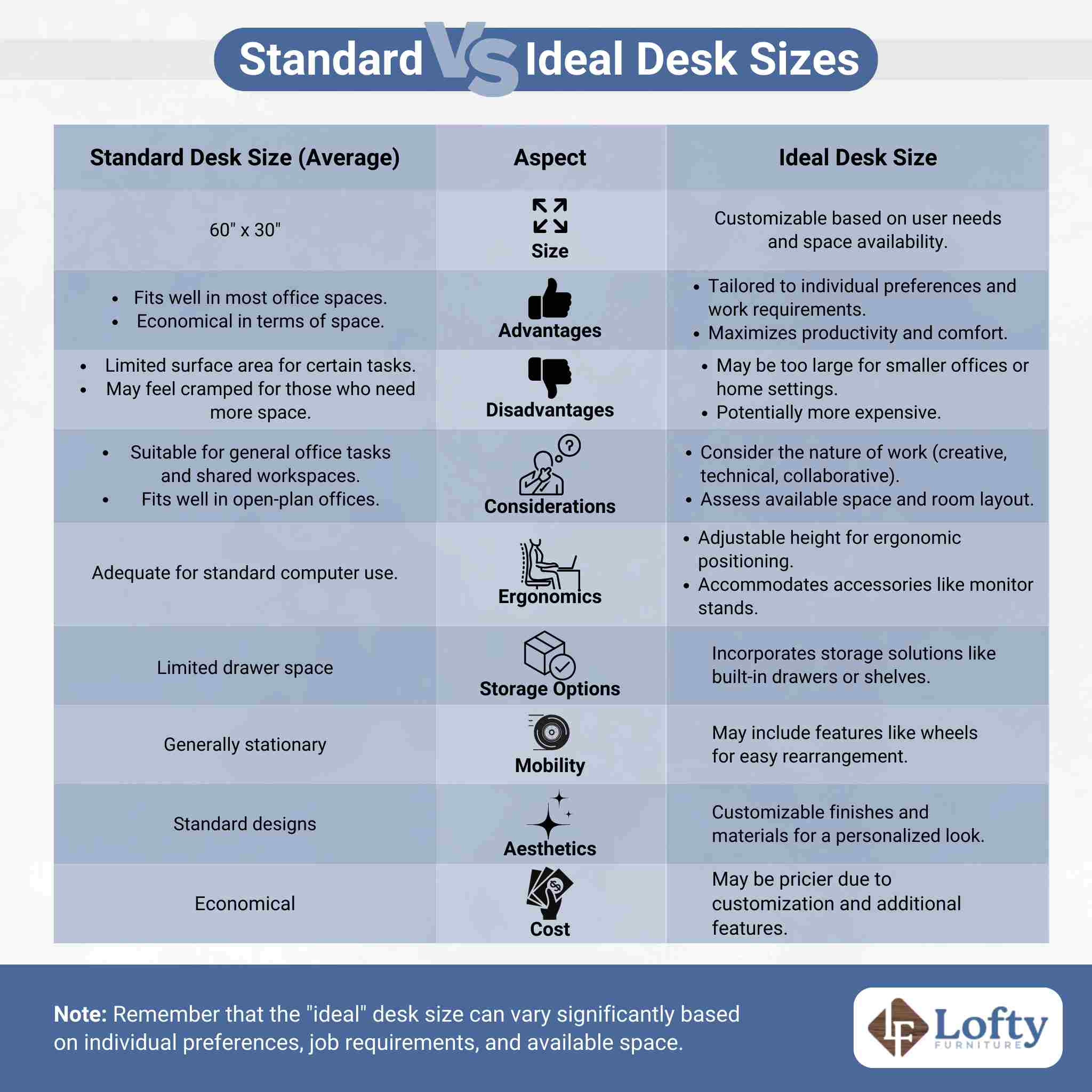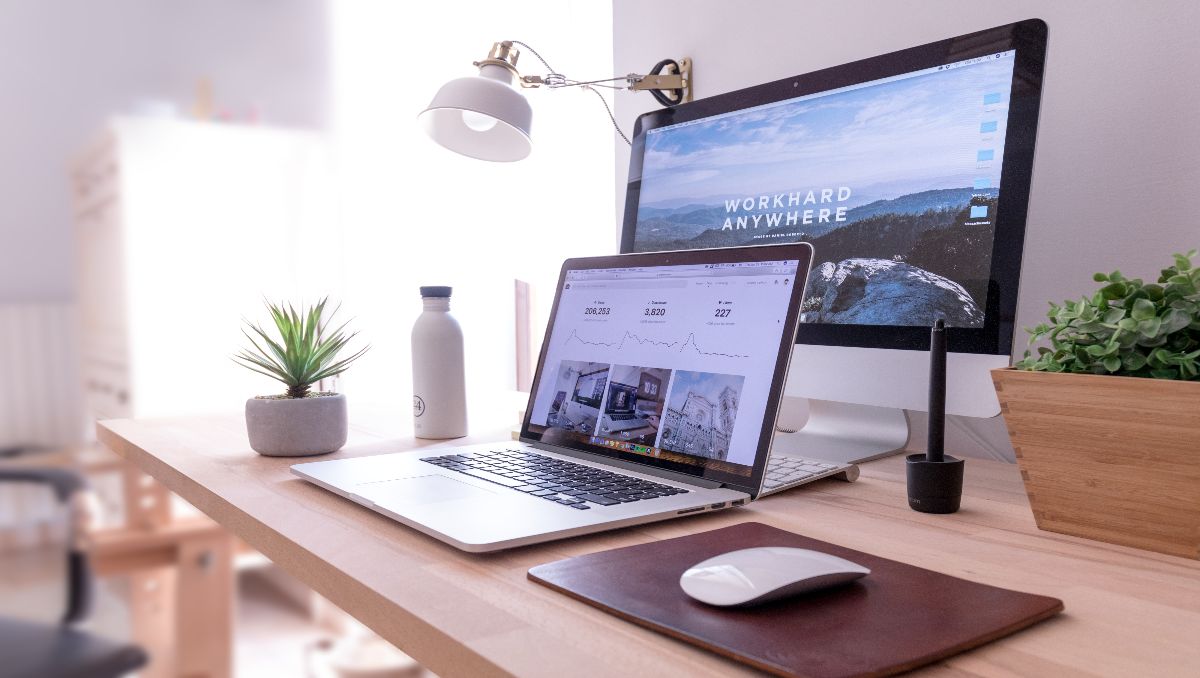Are you tired of feeling cramped and uncomfortable at your desk? Do you find yourself constantly shifting and adjusting to try and find the right position? It is time to consider the importance of desk size in creating a workspace that truly supports your needs. But what is the difference between ideal vs standard desk sizes?
The ideal desk size is personalized, focusing on ergonomic comfort and individual work habits. Standard desk sizes adhere to industry norms with dimensions like 28-30 inches in height and 48-72 inches in width. The primary difference lies in customization.
In this article, we will explore standard desk sizes versus ideal desk sizes, discuss the factors that influence their dimensions, and provide guidance on choosing the right desk size for your needs.
Standard Desk Sizes
When it comes to standard desk sizes, there are some common dimensions that you should be aware of. These dimensions can vary based on the type of desk you are considering, such as a writing or computer desk.
Common Dimensions of Standard Desks
Standard office desks often adhere to industry norms, and while there can be some variation to the different types of standing desks, here are common dimensions for standard office desks:
- Standard desk height for office desks is typically around 28 to 30 inches (71 to 76 cm).
- The depth of a standard office desk is often in the range of 24 to 30 inches (61 to 76 cm).
- Standard widths for office desks can vary but are often between 48 and 72 inches (122 to 183 cm). Some larger executive desks may be wider.
- Consideration is given to providing adequate legroom and knee space beneath the desk.
The work surface of standard desks should be spacious enough to accommodate a computer, paperwork, and other necessary items. Many office desks are designed with ergonomics in mind, with keyboard and monitor placement considerations to support comfortable and efficient work.
Standard office desks are available in various materials and designs, including traditional wood, metal, or modern materials, catering to different office aesthetics. Some standard desks are designed with built-in cable management features to keep wires organized and out of sight.
This table provides a detailed overview of standard desk sizes across various industries:

Variations Based on Desk Type
Consider the variations in dimensions based on the type of desk you choose, as this will impact your comfort and productivity. Different desk types have different dimensions to accommodate specific needs.
For example, a computer desk may have a slide-out keyboard tray or a built-in CPU holder, which can affect its overall size. On the other hand, an executive desk might be larger to provide ample space for paperwork and meetings.
Additionally, there are customization options available for desks that allow you to adjust their dimensions according to your preferences. Ergonomic adjustments such as height-adjustable desks can help reduce strain on your body and improve working posture.
It is important to consider these variations and choose a desk type with dimensions and customization options that suit your specific requirements for optimal comfort and productivity.
Ergonomic Considerations in Standard Sizes
Finding the right desk size that suits your ergonomic needs can enhance your comfort. When it comes to ergonomic design, adjustable height is crucial. This feature allows you to customize the desk’s height according to your preference, ensuring proper alignment of your wrists and arms while typing.
Additionally, back support is essential for maintaining good posture and preventing discomfort or pain. Look for desks with lumbar support, or consider using an adjustable office chair or kneeling chair with built-in lumbar support.
Keyboard placement is another crucial factor to consider. A keyboard tray that can be adjusted in height and tilt will help you maintain a neutral wrist position, reducing strain on your hands and wrists.
Lastly, monitor positioning should be at eye level to prevent neck strain. Adjustable monitor stands or mounts can help achieve the best way to sit at a desk.
Pros and Cons of Standard Desks
One vital aspect to weigh when choosing a suitable desk is its size, which can significantly impact your comfort and productivity. Regarding desk sizes, there are pros and cons to consider.
A smaller desk can be beneficial if you have limited space or prefer a minimalist setup. It can also encourage better posture and reduce clutter.
On the other hand, a larger desk provides more surface area for spreading out your work materials and allows for customization options such as adding extra monitors or storage solutions. However, it may take up more space in your room and might lead to a tendency to accumulate unnecessary items.
Ultimately, finding the optimal desk size depends on your individual needs and preferences, so take the time to evaluate what will best enhance your comfort and productivity.
Ideal Desk Sizes
When it comes to ideal desk sizes, there are some common dimensions that you should consider.
Standard Dimensions of Ideal Desks
The ideal dimensions for desks can vary based on personal preferences, the type of work being done, and the available space. However, some common guidelines for desk dimensions can provide a comfortable and functional workspace for most people.
Here are general recommendations:

- Ideal desk height is typically around 28 to 30 inches (71 to 76 cm).
- The depth of a desk is often in the range of 20 to 30 inches (51 to 76 cm).
- Width can vary, but an ideal desk width is often between 40 and 60 inches (102 to 152 cm).
If the desk includes drawers or shelves, consider the depth and height of these storage components based on your needs. Pay attention to ergonomic considerations, such as placing the keyboard, mouse, and monitor to ensure a comfortable and efficient workspace.
Some people prefer desks with adjustable features, such as height-adjustable desks, to accommodate different preferences and tasks. It is important to consider the overall layout of your workspace, especially if you have multiple monitors or specific tools you need to accommodate.
It is important to note that these are general guidelines, and the correct desk dimensions for you will depend on your specific needs and the available space in your work area.
Customization Options
Customization options are crucial in creating an ideal desk that caters to your preferences.
Adjustable features allow you to modify the desk’s height, tilt, and angle, ensuring maximum comfort and productivity.
Space optimization is another critical aspect of customization options, allowing you to add storage compartments or shelves for better organization.
Design flexibility allows you to choose from various materials, colors, and finishes that align with your aesthetic taste.
Whether adding a monitor stand or cable management system, these customization options enable you to create a desk that perfectly suits your requirements.
Ergonomic Adjustments
Creating a workstation tailored to your specific needs and preferences can have significant productivity benefits and positive health considerations. Ergonomic adjustments allow you to optimize your posture, reduce strain on your body, and minimize the risk of developing work-related injuries or discomfort.
Adjustable desk options are an excellent solution for achieving this balance. They provide height and tilt angle flexibility, allowing you to find the perfect position that promotes comfort and efficiency throughout your workday.
Whether you prefer sitting in ergonomic chair or standing desk, adjustability enables you to switch between different positions effortlessly, ensuring optimal support for your body and enhancing overall well-being in the workplace.
Benefits of Having Ideal Desks
The benefits of having ideal desk sizes vs standard desk are numerous.
Firstly, customization options allow you to tailor the desk to your work requirements. Whether you need extra surface area for multiple monitors or storage compartments for organizing documents, an ideal desk can provide it all.
Secondly, ergonomic adjustments are vital in promoting better posture and reducing strain on your body. You can create a workspace that supports good health and productivity with adjustable height settings and ergonomic accessories like keyboard trays and monitor stands.
Lastly, considering the available space in your office or home is crucial when choosing an ideal desk size. It ensures that the desk fits seamlessly into your surroundings, creating a sense of harmony in your workspace.
Factors Influencing Desk Size
When considering the factors that influence the size of your desk, there are three key points to consider. Considering these factors, you can ensure that your desk size perfectly suits your needs and preferences.

Work Requirements
To meet your work requirements, you will need a desk providing ample space for all your necessary equipment and materials.
Work requirements can vary greatly depending on the nature of your job and the tasks you perform daily. Space limitations are important when choosing a desk size, as you want to ensure that it fits comfortably in your workspace without feeling cramped.
Personal preferences also play a role, as some individuals prefer larger desks with plenty of surface area, while others may require more storage options.
Budget considerations are another factor to keep in mind, as larger desks tend to be more expensive.
Finally, productivity factors should be considered, such as having enough room to spread documents or set up multiple monitors if needed.
Available Space
Consider the space available in your workspace when choosing a desk that fits your work requirements. Space optimization is crucial for creating an efficient and comfortable work environment.
To maximize productivity, it is essential to plan your furniture layout carefully. Look for compact solutions that fit seamlessly into smaller spaces while providing ample workspace. Creative storage solutions are also important to keep your desk clutter-free and organized. Utilize shelves, drawers, and organizers to store all office supplies within arm’s reach.
By strategically incorporating these elements, you can make the most of the available space and create a functional and inviting workspace that meets your practical needs and aesthetic preferences.
Technology Integration
Integrate your technology seamlessly into your workspace for an efficient and engaging experience. Regarding desk ergonomics, having a well-designed setup can significantly enhance your productivity.
Start by considering the placement of your computer monitor at eye level to prevent strain on your neck and eyes. Invest in a comfortable keyboard and mouse for easy typing and navigation. Utilize productivity tools such as task management apps or digital calendars to stay organized and on top of deadlines.
Keep cables with clips or zip ties neatly organized to avoid tangling and tripping hazards. Consider adding a docking station or USB hub to connect your devices easily.
Incorporating these technology integration techniques into your workspace allows you to create a harmonious environment that promotes efficiency and enhances your overall work experience.
The Comparison: Standard vs Ideal Desk Sizes
When comparing standard vs ideal desk sizes, it is important to note both of their significant differences.

Industry standards often determine standard desk dimensions and tend to be more generic in nature. On the other hand, ideal desk sizes consider ergonomic design principles that prioritize comfort and productivity.
The benefits of having an ideal desk size cannot be overstated. A properly sized desk allows for better posture, reducing strain on your neck, back, and wrists. It also provides ample space for all your work essentials without feeling cramped or cluttered. This can significantly enhance your focus and efficiency throughout the day.
Several factors influence the choice of a desk size that suits you. Firstly, consider the type of work you do and how much space you need to accommodate your equipment and materials. Secondly, take into account your body proportions to ensure proper ergonomics. Lastly, consider the available space in your office or workspace.
Choosing the right desk size is crucial for creating a productive and comfortable work environment. Considering ergonomic principles and personal factors, you can find an ideal desk size that suits your needs and aesthetics.
How to Choose the Right Desk Size

Now that you understand the differences between standard and ideal desk sizes, let’s dive into how to choose the right desk size for your needs. It is crucial to find a desk that fits your space and promotes productivity and comfort.
One of the first things to consider is customization options. Look for desks that offer adjustable features such as height, tilt, and storage solutions. These ergonomic adjustments can greatly enhance your working experience by allowing you to customize the desk to your needs.
The benefits of choosing an ideal desk size are numerous. A properly sized desk can improve posture and increase overall productivity. Providing ample workspace allows you to organize your materials efficiently and work comfortably.
Several factors influence the size of the desk you should choose. Firstly, consider your work requirements—are you mainly using a computer, or do you require additional space for paperwork or other equipment? Secondly, take into account the available space in your office or home.
By carefully considering these factors and exploring different customization options available in desks, you can conveniently create a workspace that truly belongs to you.
You might be interested to learn about the ergonomic advantages of a standing desk for a dynamic and health-conscious workspace.
Finding Your Fit: Ideal vs Standard Desk Sizes
In conclusion, when choosing the right desk size for your workspace, it is important to consider both standard and ideal dimensions.
While standard sizes provide a baseline for functionality, ideal sizes take into account personal preferences and ergonomic factors. Factors like available space, work requirements, and body proportions should guide your decision-making process.
Remember, finding the perfect desk size is like finding the perfect pair of shoes – it should fit just right and make you feel comfortable throughout your workday.


